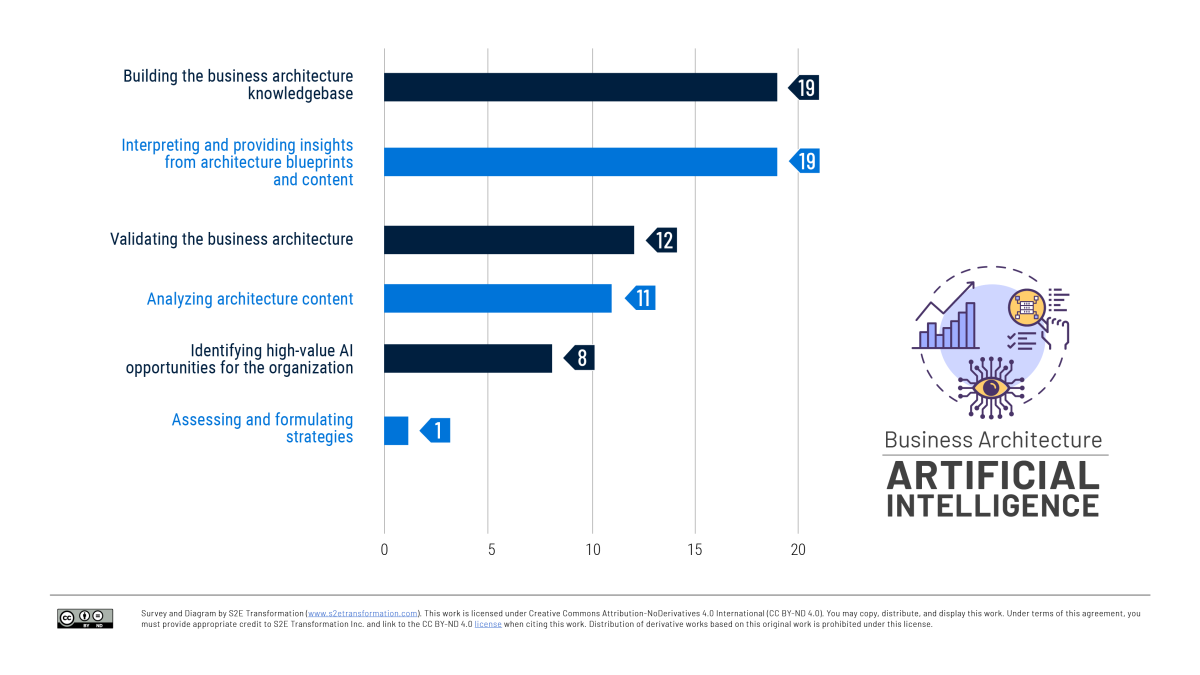In just a short period, business architecture teams have begun redefining their impact through AI—discovering inventive ways to accelerate outcomes and expand their strategic value. The survey suggests that this is only the beginning, as organizations rapidly identify new frontiers for AI-driven advancements.
In addition to the options shown on the survey, there were two additional thoughtful ways to leverage AI within a business architecture context:
- Leverage AI to perform business architecture activities – For example, “where can AI actually take over business architecture tasks... can it create and execute a survey to gather VOC? Can it create the assessment? Can it create architecture diagrams and assemble the read out that aligns capabilities and identifies where we weren't aligned for us? Can it join the meeting and wear hats as the challenger?”
- Business architecture as a construct for leveraging AI – “How could the AI as Coordination – a concept from Sangeet Paul Choudary – be leveraged within business architecture? “The reason Business Architecture and AI as Coordination could be an ideal pairing is due to their alignment within the level of abstraction. If one is focused on the automation of tasks with AI, the focus shifts to a lower level of abstraction and representation. Value streams are in better alignment with leveraging AI as Coordination. Coordination being defined as the ability to align the actions and decisions of multiple independent agents, whether people or institutions, so they can collectively achieve an outcome they couldn’t achieve alone.” Value streams with enabling capabilities cross-mapped is indeed a powerful blueprint for leveraging AI and bringing players together to achieve collective value and outcomes.
A selection of other thoughtful comments shared are below:
- “AI is essential to a current, highly visible engagement I’m leading. My business stakeholder started with an inventory of 170 systems that I mapped to capabilities (business and functional), and value streams. Analysis was done on duplication, overlap, and redundancy. From there, we eventually got to unique journeys (business request), and now we can truly start defining what strategy execution looks like. I’ve been pleasantly surprised at its efficiency. I asked our AI tool how long the exercise would take without its use. AI responded that what took me about 2-4 weeks would take a team of 3 a full fiscal quarter without AI capabilities. :)”
- “We're looking to support blueprinting and portfolio insights through autonomous mapping of portfolio initiatives to enterprise business capabilities.”
- “I have used AI as a support agent (tool) to generate create draft capabilities and descriptions. Have also provided the model as an input for some analysis but I did not find it very accurate so it was not used for insights. Continue to look for ways to utilize.”
- “We've somewhat opened pandoras box, and have found these tools to be very powerful. We haven't put anything into production yet, but have some strong experiments in place, and hope to make headway in the coming 6-12 months.”
- “There is a lot of AI hype these days, well knowingly that business architecture is tailored differently for each company that adopts it. Business architecture addresses company specific strategies…However there could be small elements of business architecture to be investigated in text based GenAI as a start point for example. Anything which is text based can be input in a text based AI prompt since it is designed for optimizing text based inquiries. One example could be generating a generic industry business capability model or a very high level information map based on the generated input. The first input can then refined and adapted to its real usage in the company. ChatGpt already has content that addresses what AI can be used for - based on what is available as information about the company. However this can never stand alone since it is generalized.”
- “Uploading various business architecture blueprints (e.g. BCM, value streams, business model canvas, etc.) into NotebookLM to use as the basis for various prompts.”
